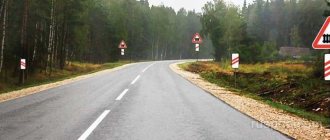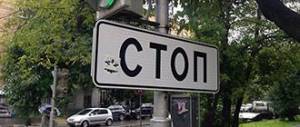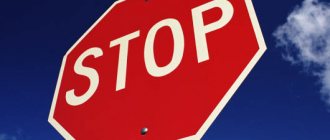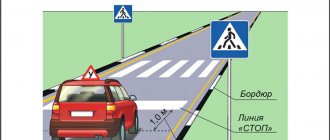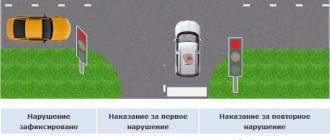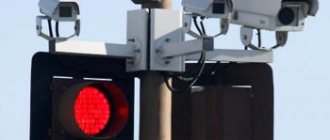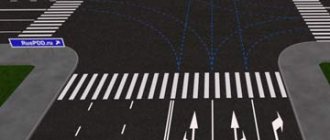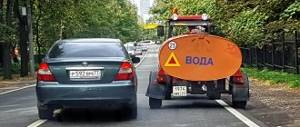What is a stop line and why is it needed?
The stop line is marking 1.12, which obliges drivers of wheeled vehicles to stop in front of it. This marking corresponds to road sign 6.16. In fact, the stop line is not always accompanied by this sign, but almost always it is accompanied by the designation 2.5 “Moving without stopping is prohibited” (STOP).
This markup is needed in order to:
- Vehicles stopped at a safe distance from the pedestrian crossing. The distance from the zebra crossing is especially important in winter and spring, since ice and snow increase the braking distance. Marking 1.12 is applied at a distance of at least 1 meter from the pedestrian crossing.
- There was enough space to perform maneuvers. This point is especially important for cargo vehicles.
- Vehicles moving perpendicularly could cross this section of the road without hindrance.
The stop line can be located in front of the railway crossing at a distance of at least five meters from the barrier or 10 meters from the nearest rail.
What are the ways to indicate markings?
Marking 1.12 looks like a filled white line located across the strip. Road sign 6.16 duplicates its meaning, and 2.5 obliges the motorist to stop. The stop line may be accompanied by the word STOP or STOP printed on the road surface along markings 6.16.
What it looks like and what it means
The stop sign in the traffic rules belongs to the priority group. This road symbol is called “Driving without stopping is prohibited” and has a serial number of 2.5. The appearance of the sign fully corresponds to its content.
The main distinguishing feature of the symbol is its regular octagonal shape. This approach made it possible to distinguish an object from a group of others so that traffic participants would not confuse it with anything else.
The 2.5 road symbol is red. There is a thin white border along the edge, and the word “STOP” is written in large white letters in the center. In accordance with the rules, the sign can be installed on a permanent basis or temporary. In both cases it looks the same.
Traffic regulations require the installation of “STOP” signs in the following places:
- Before railway crossings that are not equipped with a traffic light and do not have a person on duty.
- A few meters from the railway, provided that repair work is underway there.
- Before quarantine posts.
- At intersections without traffic lights.
- On adjacent territories or secondary roads before entering the main road.
The sign is used in places with poor visibility. Stopping allows the driver to look around and make the right decision about further movement.
Rules for crossing a railway crossing with a sign
The general rules for the passage of railway crossings are set out in the traffic rules, which came into force on the basis of Government Decree No. 1090. In Art. 15 states that when crossing a railway crossing, it is necessary to follow road signs, traffic signals, the duty officer’s regulation, and markings.
A STOP sign is most often placed in front of a railway track that is not equipped with barriers. It can be supplemented with a traffic light or located without it. If there is no traffic light, then only such a stop allows the driver to assess the situation at a safe distance from the rails.
The presence of symbol 2.5 indicates that moving further without stopping is prohibited. Failure to comply with the established rules entails the application of penalties.
According to the prescribed standards, you should stop immediately in front of the “STOP” sign or a drawn stop line, but no closer than 10 meters from the railway track. Otherwise, the moving train may catch the car and cause an emergency.
Is there a sign at a railway crossing with a traffic light?
Often a “STOP” road sign is installed together with a traffic light. Many car owners are confused and do not understand whether to follow the road rules in this case. The answer is clear - if the traffic light is working, it is the one that has priority, which means there is no need to stop at the STOP sign.
The driver is required to stop in front of the “STOP” sign or in front of the stop line, if one is drawn, only if the traffic light is not working. The stop lasts several seconds, during which you can view the visible section of the path and determine the presence or absence of danger.
In cases where a red light prohibits passage, you must stop before the STOP sign. You can continue driving only after the red traffic light turns off.
Correct stopping before marking in various situations
You need to stop immediately before the markings, without going over them. In addition, it is considered a violation not only to drive with wheels, but also with a bumper. But it is important to remember the following rules:
- You need to stop only when there is a prohibitory signal from a traffic light or a traffic controller. That is, if the light is green, there is no need to stop;
- There are no priority signs at signalized intersections. This means that when the traffic light is green, you do not need to comply with the requirements of sign 2.5. But if the traffic light breaks down or is turned off, then it is imperative to follow the instructions of the sign.
For a correct stop, you can navigate in this way: as soon as the line disappears from view (from the driver’s seat), you need to stop so as not to run over either the bumper or the wheels.
Stop line in front of a railway crossing
Question about the rules for traveling across railway tracks:
At the railway crossing, the light signaling does not work (the traffic light is installed, but neither the white-lunar nor the red color is on). Is it necessary to stop before the stop line in this case?
Answer. The term “stop line” means marking 1.12. Until July 12, 2021, it had its own name, “stop line.” After adjusting the traffic rules, the name was removed, but the meaning did not change.
If the situation in front of the railway crossing really corresponds to the description (there is a non-working traffic light and there is no 2.5 sign requiring a mandatory stop), then if the traffic light is not working, you do NOT need to stop in front of the stop line.
A traffic light may not work for various reasons, and at the moment when none of its lights are lit, the crossing is considered unregulated. In the presented situation, nothing prohibits you from continuing to move across the tracks without stopping, but this does not mean that you can relax your vigilance.
Marking 1.12 is used in places where traffic is regulated by traffic lights and before railway crossings. This marking indicates the place where, in general cases, the driver must stop when there is a prohibiting signal from a traffic light (regulator) or when there is a sign 2.5 “Driving without stopping is prohibited.”
The legal requirement to stop before the stop line at a railway crossing is provided by either a prohibitory signal from a traffic light (or a person on duty at the railway crossing) or a sign 2.5 “Moving without stopping is prohibited.”
The fine for failure to comply with the requirement to stop at the stop line before a railway crossing (for passing the stop line) as of the date of publication is 1000 rubles. (according to Article 12.10 Part 2). For traveling through railway tracks when travel is prohibited, the penalty bar increases (Article 12.10, Part 1) - a fine of 1000 rubles. or deprivation of rights for up to six months. In case of repeated violation - deprivation of rights for 1 year.
For reference: sign 2.5 “Moving without stopping is prohibited” is installed at unregulated railway crossings without a person on duty. But this sign can be found in a group with a traffic light, for example, consisting of two red signals located horizontally. Such a traffic light turns on (two red lights flashing alternately) before a train approaches. The rest of the time it does not light up, i.e. Does not work.
Therefore, if you come across a combination of a broken traffic light + sign 2.5 before a railway crossing, then you need to comply with the requirement of sign 2.5 - stop, look around and continue driving after stopping.
At railway crossings, marking 1.12 (the former name of the stop line) is applied at a distance of 5 m from the barrier or traffic light, and in their absence - at a distance of 10 m from the nearest rail in one alignment with sign 2.5 “Movement without stopping is prohibited.”
Instead of marking 1.12 (the former name of the stop line), sign 6.16 “Stop line” can be installed at an unregulated railway crossing; its function is exactly the same as that of marking 1.12 - it indicates the place where the driver must stop when there is a prohibiting traffic light signal (move guard on duty) or in the presence of sign 2.5 “Moving without stopping is prohibited.”
Be careful when crossing railroad tracks.
What are the controversial situations?
The most common dispute arises when the driver does not drive onto the line with his wheels, but crosses it with his bumper. In this case, a fine will be imposed, no matter how the motorist argues with the inspectors. The stop line means that not a single part of the car will go beyond its limits, since in this case the car occupies a space not intended for it at a certain point in time (while the traffic light is red, for example).
Another dispute may arise as a result of the incorrect location of sign 2.5 in relation to marking 1.12. They must be on the same level. If they are located in different planes, then the cameras (taking into account the shooting angle and distortion) will record a stop further than the sign (but in front of the line) as a violation. If the sign and the markings are not on the same plane, then you should stop in front of the one that is located earlier (that is, further from the intersection).
A lot depends on the shooting angle and the location of the camera: a fine can come even if the line is crossed by the shadow of a car bumper. For this reason, you should not press close to the markings or signs: it is better to maintain your distance.
Clause 6.13 of the Russian Traffic Regulations states that in the absence of a stop line, the driver of the vehicle must stop in front of the intersection so as not to interfere with pedestrians.
Intersection rules
Incorrect crossing of the stop line occurs in two cases: either the driver is not familiar with the traffic rules, or the traffic within the city is too intense and difficult. In fact, the algorithm of actions on the part of the driver is extremely simple: the movement must be stopped immediately as soon as the stop line is under the hood of the car.
If the driver does not have a good sense of the dimensions of his own car, he must stop as soon as the markings disappear from view. This method is universal among beginners.
If the driver stops correctly, the view of the traffic light located above the road will be completely open - this is what the markings are designed for. In order not to receive a fine for crossing the stop line, it is worth analyzing all the conditions for placing the markings in question:
- If a stop line is placed at a controlled pedestrian crossing, it is necessary to stop only when this is indicated by the actions of the traffic controller or a red traffic light. In other cases, you can freely cross the line.
- At a controlled intersection the situation is similar.
- If the intersection is unregulated, there must be a “STOP” sign; therefore, the driver stops and makes sure that his vehicle does not interfere with other road users.
- If we are talking about a controlled railway intersection, the procedure is similar to the first point.
- Driving through an unregulated railway intersection is regulated by the same rules as point 3.
This is interesting: 9 main fines for illegal parking in 2018 and advice from a car lawyer on how to avoid them
Amount of fine for violation
Driving beyond the stop line (entering it), as well as signs 6.16 and 2.5, is one of the most common violations. This offense entails a fine of 800 rubles. If the violation is repeated, the amount of the fine increases (up to a maximum of 5 thousand rubles), but in the worst case, the driver may be deprived of the right to drive a vehicle for up to 6 months. But this punishment applies to those who violated the rule at a controlled intersection.
If a driver drives beyond a stop line or a corresponding sign at an unregulated road intersection, the fine will be 500 rubles. When paying fines within 20 days from the date of receipt, a 50% discount applies.
| Did not find an answer to your question? Call a lawyer! Moscow: +7 (499) 110-89-42 St. Petersburg: +7 (812) 385-56-34 Russia: +7 (499) 755-96-84 |
Violations are recorded using cameras. If the car owner does not agree with the fine, he can appeal it within 10 days, but he must have evidence of his innocence. If a motorist receives a fine due to the fact that the signs and markings were located incorrectly (did not correspond to each other), then you can file a complaint with the traffic inspectorate. If it is established that road signs are located incorrectly, the fine will be canceled and installation will be carried out in the disputed area.
